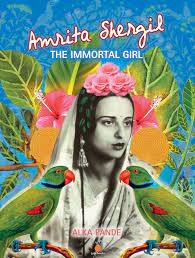Amrita Shergil...born to be an artist
- JoAnne Saldanha
- Oct 25, 2021
- 3 min read
There are times as an educator, when the children’s comments can make it painfully clear that you have not thought out or planned the ideas you hope to take to them, well enough.
When we focussed on art themed books last term, I failed to noticed that not a single book about a female artist featured on my list. When I think back, I feel embarrassed and rather guilty, especially as a female educator, to completely miss this. It was only when the children pointed it out to me, that I realised my mistake.
I had toyed with books about Georgia O’Keefe and Frida Kahlo, but somehow hadn’t taken to the writing and just went on with books and artists I connected with, with out focussing on their gender. I wish I had done Frida Kahlo, as the artist we read about last week is often called the Indian Frida, but since I found this book just a week before school reopened, she hadn’t been in my plan.
So when I pulled our “MY NAME IS AMRITA...born to be an artist” by Anjali Raghbeer, published by Tulika, last week, I was happy to feature not just a female artist, but one whose work I love and and Indian, to boot. ( well, half Indian...but you get my drift?!!)

Written in the style of her diary, the book focuses on the story of Amrita Sher-Gil’s life, from childhood upto age 16 when she goes to Paris to study art the Ecole Nationale des Beaux Arts. Including extracts from the artists own childhood diaries, her writing as well as her sketches. The photographs of the artists childhood, helped the children connect with her.
While the book doesn’t quite flow and makes for an awkward read aloud, the fact that the artists own childhood work was featured, held the children’s interest. The sketches and imaginative stories echoed with many of the children who love to draw or write from their own imagination.

In response to this book, my younger students drew from Amrita’s childhood love for illustrating stories that her mother narrated to her and drew from her sketches of a ‘miracle tree’, to create miracle or magical items. Children thought about what miracle item they would like at their disposal, drew it and wrote or orally explained what it could do.

During exercises like this, I illustrate what I want them to do, with an example.
In this case, I showed them the glass I was drinking from and claimed that it would provide me with whatever I wanted to drink. All I needed to do is to say the name and the glass would give me orange juice or water or coconut water, or chocolate milkshake.
I make a mental note of the children who come up with ideas that are exactly like mine. These children have yet to be able to form their own ideas or need to be offered the space to work on their imagination and creativity. I also quietly whoop with delight when they finally do!!

My 5th and 6th graders harnessed Amrita’s propensity for self-portraits, to reflect about themselves and create a “wordy self-portrait”. This proved to be an interesting exercise as some tried to draw out the shape of their face or their hair styles in ‘portrait’ style, while filling up their ‘self-portraits’ with words...drawing from how they saw themselves.
When I prepare for a session, if possible, I try to read up some more about the artist so that when questions do come my way, I have some knowledge about the artist. There is always the probability that I am unable to answer, when that happens I make sure I do get back to the children. I referred to another two Indian published books REBEL WITH A PAINTBRUSH by Anita Vaccharajani and AMRITA SHERGIL THE IMMORTAL GIRL by Alka Pande. The former I highly recommend for older students, the later...intends to be a picture book meant for children, written in a style that would be more appealing to grown ups.
SEL Competencies explored with the response activities....Self Awareness.
























Comments